I began my review of Huawei’s previous offering, the Mate 20 Pro by calling it “the most complete smartphone that has ever crossed my desk.” So when I set off, in March of this year, to Paris with a contingent of some fifty UK journalists for the launch of the Chinese company’s new P30 series of smartphones I was preparing myself for mild disappointment.
Why? The previous year, Gang He, president of the company’s mobile phone unit, had explained the difference between the two sub-brands by saying that the Mate series focusses on the latest, beefiest processor while the “P” in P Series lays the emphasis on photography and lifestyle.
In my simplistic, old geezer, pre-Weinstein mindset this translated as “Mate for Men, P Series for Girls”. Or, if you prefer, Butch versus Bling.
It turns out, as so often before, I was mistaken.
 OH, BUT HOLD ON… Shouldn’t we first be addressing the pachyderm on the premises? I’m talking, of course, about the US relegation of Huawei to the Entity List. And the global implications thereof.
OH, BUT HOLD ON… Shouldn’t we first be addressing the pachyderm on the premises? I’m talking, of course, about the US relegation of Huawei to the Entity List. And the global implications thereof.
Yes. Oh, yes, this is a big one.
This has certainly influenced Tested Technology’s approach to this particular review. I know we’re not here to talk politics, but this thing is unavoidable.
Premonition
Perhaps I should have seen it as a warning. The promotional booklet that we were provided with at the Paris launch was titled “Rethink What’s Possible”.
At the time it seemed like a typical empty marketing slogan. But recent events have brought it sharply into focus.
I was right to give the Mate 20 Pro top marks. But, as I’ve subsequently learnt, in some small but significant ways the new Huawei P30 Pro is an even better phone. A month ago it seemed entirely possible that I would be recommending it to you unreservedly.
Today, other factors loom. A shadow lies over both phones, over all Huawei’s products. And perhaps, in time, over any technology coming out of China.
I’m having to rethink what’s possible…
The Hardware Proposition
 But let’s get the physical facts of the phone quickly out of the way first. You want this phone because it’s slim (7.4mm wide, 158mm deep and 8.41mm thick), because that form-factor is practically all screen (6.47″ diagonal OLED with a small dew-drop cutout for the selfie camera), because the 4100mAh battery will see you through the busy day and leave you enough reserve for a second day if you need it, because it will fast charge using the supplied 40w charger from 0-70% in half an hour, and because it includes wireless charging from any standard Qi charger.
But let’s get the physical facts of the phone quickly out of the way first. You want this phone because it’s slim (7.4mm wide, 158mm deep and 8.41mm thick), because that form-factor is practically all screen (6.47″ diagonal OLED with a small dew-drop cutout for the selfie camera), because the 4100mAh battery will see you through the busy day and leave you enough reserve for a second day if you need it, because it will fast charge using the supplied 40w charger from 0-70% in half an hour, and because it includes wireless charging from any standard Qi charger.
You want this phone because it is built around the same punchy, intelligent Kirin 980 Octa-core Processor used in the Mate 20 Pro, playing to 8GB of RAM with storage of 128GB (or 512GB if you pay more).
This is all good: specs that tell you this is a state-of-the-art modern smartphone backed up by a reviewer telling you that after a couple of months living with the device it fulfils every promise of those specs. But there’s more…

Literally snapped from a bus and shot through glass as we passed over the Seine. OK, yes, I’ve used the Snapseed Android photo editor to lighten the foreground and emphasis the red scooter. But the P30 Pro gets all the detail you need to make this work.
Photography
You really want this phone because of its spectacular and extraordinary photographic possibilities.
I say “possibilities” not as a typical marketeer hedge (as in “up to 60% off”) but to acknowledge that the most important factor behind any photograph is the photographer, not the camera. If you’re a dreadful photographer you can continue to take dreadful photographs with this phone (and I have my own dismal collection of these to prove it).
But if the moment is right, and you are right for the moment, this is a device that won’t let you down. I’ve had a few, very expensive full-blown cameras pass through my hands over the years, but I have never previously been able to attain a shot anywhere near as good as several I’ve managed to snatch with this Huawei P30 Pro.
The Cameras
There are five cameras in all. The selfie camera has an f-2.0 aperture directing the photons onto a 32MP sensor. That figure of 32 means something rather different now that cameras are getting very smart. Depending on the context, the camera won’t always use all of the pixels individually, so the metric isn’t directly relatable to resolution.

Selfie smile detection seems somewhat coarsely grained. Mona Lisa would have been well under the radar.
DXOmark gives the P30 Pro’s selfie camera a high general score for stills and video. But it notes that the camera is only fixed focus, best at about 55 centimetres. Trying to fill the frame with your face (if you’re so inclined) with the phone about six inches from your nose, still leaves you with an acceptable image, but with some visible blurring. Likewise, a long selfie stick will also reproduce your face as a slightly woolly image. But for standard selfies at arms length the focus is crisp.
Face detection balances the exposure in your favour against over-bright backgrounds, and the selfie camera also offers smile detection.
In theory. My test P30 Pro doesn’t seem to be tuned for nuance in the smile department: excessive gurning is apparently required to trigger the shutter.
Compared with the Mate 20 Pro’s selfie camera, which was supplemented by a sophisticated 3D depth scanner (at the expense of a wide notch at the top of the screen) the P30 Pro’s equivalent is just a Box Brownie—albeit backed up by very smart software behind the scenes.
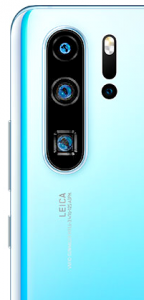 The main camera, or camera array as I’d prefer to call it, is the big deal here. In principle it’s very similar in concept to the Mate 20 Pro main camera, with the following differences:
The main camera, or camera array as I’d prefer to call it, is the big deal here. In principle it’s very similar in concept to the Mate 20 Pro main camera, with the following differences:
- The central camera has a 40MP sensor that uses pixel binning and an RYYB version of the standard Bayer colour filter.
- Depth sensing using ToF has been moved from the selfie camera to the main camera.
- With the addition of depth sensing there are now four cameras in the array instead of three.
- The lowest camera in the vertical array of three uses an optical telephoto lens stack.
I was puzzled at first by the use of RYYB (red, a pair of yellows and a blue) instead of the standard RGGB Bayer filter.
I can understand how—in Bayer’s original concept—you derive a full colour palette from the three primary colours, and I could see how using yellow instead of green would allow more photons through the filter (Huawei claims 40% more) because the yellow filter is accepting both green and red photons.
However, on reflection I realised that this simply introduced one more step in decoding the data. As the yellow data includes the count of the red and the green photons, and we already know from the red filter how many of those are red, we can arrive at the green count using simple subtraction. (As with the original Bayer, we’re assuming that each filter in the cluster of four is receiving the identical mix of colours.)
This requires more compute power than the traditional Bayer approach, but the Kirin 980 is easily up to the job.
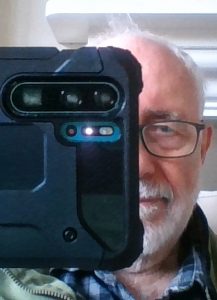
Getting to grips with ToF (Time of Flight) was another challenge. This camera doesn’t record pictures—its sole duty is to assess the distance of different objects in the field of view, so that software algorithms can create effects like bokeh, the out-of-focus softening characteristic of wide-aperture dedicated cameras.
Based on information from DXOMark (very definitely worth a read, if you want more details), it seems that this differs from the 3D scanning system used with the selfie camera on the Mate 20 Pro, which used an infra-red array to illuminate the field. DXO describes the P30 Pro’s ToF camera as using a “laser”.
I’m a little dubious about “laser”, though. This ToF technique requires the whole field to be illuminated simultaneously. A laser could fast scan, perhaps, but that’s very unlikely. It could also be used to stimulate an intermediate phosphor element to beam non-coherent light, as with some laser projectors.
But this ToF technique requires narrow-frequency light. My bet is on infra-red.
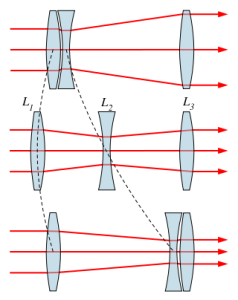 The optical telephoto stack is a smartphone innovation you’re going to see a lot more of, whatever happens to Huawei. Over the past five years, smartphones have got rather clever at offering various modes of zoom, but ultimately these all boil down to software algorithms that don’t do much more than digitally blow up a cropped section of the full image.
The optical telephoto stack is a smartphone innovation you’re going to see a lot more of, whatever happens to Huawei. Over the past five years, smartphones have got rather clever at offering various modes of zoom, but ultimately these all boil down to software algorithms that don’t do much more than digitally blow up a cropped section of the full image.
A proper optical zoom requires a minimum of three lenses, zooming being accomplished by moving at least one of the lenses relative to the others. The diagram (borrowed from Wikipedia) illustrates the problem this represents for incorporation in a smartphone. The double concave lens in the middle has to traverse a meaningful distance to effect the zoom. In a smartphone, the option would be either to design a rather thick phone or allow for a prominent “camera bump”. Neither solution would be acceptable in today’s market.
The solution Huawei provides is to turn this telephoto lens stack sideways and run its axis parallel to the phone’s screen. But rather than shooting out of the side of the camera, the stack looks directly into a triangular prism that acts like a 90 degree mirror so that it’s pointing in the same direction as the other main cameras.
Huawei describes this as a 10x hybrid zoom, although in fact, its optical capabilities hit their limit at 5x. At this point, the “hybrid” part takes over. Using what Huawei calls “field-of-view fusion”, the camera starts combing optical and algorithmic digital zooming. The algorithms almost certainly involve a version of super-resolution, the technique of improving the resolution by fusing multiple different shots of the same picture.
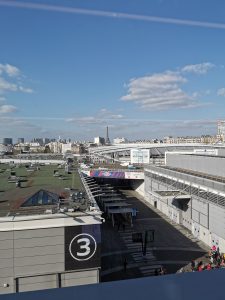
Is “10x zoom” a marketing cheat? The question answers itself once you start using this zoom. Which, in my case, was immediately after the launch in Paris, and soon as we journalists laid our hands on our sample P30 Pros.
The Paris Convention Centre where the event was held is a little over 2 miles away from the Eiffel Tower by line of sight, and indeed you can just about see France’s famous national monument from the Convention Centre’s massive North-facing windows.
This first shot fairly presents the view as seen by the human eye—the Eiffel Tower is in the dead centre of the picture.
 I then started zooming in. Nothing special here, no selecting of a particular lens, just the standard finger-and-thumb unsqueeze across the screen. The shot you see here well exceeds even the 10x hybrid zoom, but is still perfectly crisp and detailed.
I then started zooming in. Nothing special here, no selecting of a particular lens, just the standard finger-and-thumb unsqueeze across the screen. The shot you see here well exceeds even the 10x hybrid zoom, but is still perfectly crisp and detailed.
News of this monstrous proposed erection greatly alarmed many of the local residents, who believed that the presence of all that iron in the vicinity would magnetically draw out the nails from their houses and the cutlery from their kitchens.

If I’d been lugging that kit with me all the way from London… If I’d have the price of five P30 Pros to buy the kit in the first place… And if I’d remembered to bring my tripod… The shots you see were taken hand-held. Through a glass window.
One truly remarkable feature of the P30 Pro’s telephoto camera is its performance in low light. At the launch, Huawei demonstrated this by turning out the lights and shooting a small logo from the back of the auditorium.
By way of comparison, we were offered the same shots taken at the same time from an iPhone and a Samsung phone.
As you’ll have guessed, the Huawei phone won hands down—with an image so crisp it made me gasp. I wasn’t sure at the time whether my gasp was at the technical achievement or was it perhaps at the sheer audacity of Huawei daring to go public with such a palpably fake demonstration? Either way, I evidently had to get my hands on this device ASAP.
I had to wait until we got back to the hotel that evening to test the low light shooting. And, yes, that telephoto lens does exactly what Huawei says it does. What Huawei doesn’t tell you—which isn’t to say they’re in any way pulling the wool over your eyes—is that this low light telephoto feature stops dead at 10x zoom.
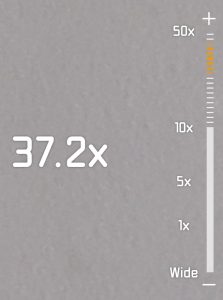
Calibration marks when using thumb-and-finger zooming.
You need to know this because the whole zoom arrangement, apart from this surprise, is seamless. Calibration marks appear on the screen in Photo mode offering Wide, 1x, 5x and 10x. You can tap on these to go directly to the relevant zoom factor, or (as you’re much more likely to end up doing) you can thumb-and-finger to any zoom factor up to 50x. This free-form zooming changes the individual calibration marks into a sliding scale, so you can always read off the zoom factor you’re using.
In normal light, you simply grab the zoom factor that works best and take your shot. There’s seem to be no effective difference in quality between, say, 9.9x and 10.5x, although the P30 Pro will, in fact, have switched the mixture of cameras it uses to create the shot.
The low-light zoom, however, only works when the telephoto is the sole camera. Go even one decimal place beyond 10x in a low light situation and the almost clear as day view the telephoto lens provides will switch to gloom or dark night.
More About the Camera
There’s a good deal more to the P30 Pro’s camera arrangement than we’re able to cover here. Many of the features of the Mate 20 Pro have been carried over, so if you want to know more, read that review. The ability to capture in RAW using Pro mode, which gives you extensive manual control, excellent super-macro mode, panorama shots, night mode, slow motion, very good document scanning, the fast double-press on the volume down button to take an instant picture when the screen is off, voice triggering the shutter—these Mate 20 Pro features are all there in the P30 Pro.
Video shooting has been somewhat improved since the Mate 20 Pro, with noticeably better optical image stabilisation (OIS—physically moving the lens) and artificial intelligence stabilisation (AIS—applying shape recognition to synthesise stable frames). DXO says of the video:
…the Huawei P30 Pro achieves a good score for Video, making the device a great all-around mobile imaging option… Video image stabilization on the P30 Pro is one of the best we have seen, thanks to an efficient combination of optical and electronic image stabilization.
One new feature I almost forgot to mention (because I don’t, frankly, see much use for it) is the ability to fire up two of the cameras at the same time to take two different video clips simultaneously side by side. This uses the main camera to shoot the wide shot and the telephoto lens for the close shot. Possibly invaluable for a surveyor or insurance adjuster needing to put damage detail in the context of the whole scene. But it’s a challenge to find another use for it, particularly as it only applies to movies, not stills.
And What Else…
We’ve focussed on the camera (ha!) because it’s the most interesting and innovative part of the P30 Pro. To the extent that you might even wonder why we continue to call these things “phones”. I rushed through its general merits in “The Hardware Proposition” section above. I haven’t touched on the software because by and large it’s much the same as the Mate 20 Pro, which you can read about here.
One software change worth mentioning, however, is the addition of some bloatware. I write about how to deal with it in this Data Sheet.
But the really big “What Else” brings us back to that elephant in the room.
This is undoubtedly a great flagship smartphone. But, in the light of this new vast cloud the Trump administration has managed to float over it, should you buy it?
Would I buy it? No, not at the current retail price of around £900 for the 128GB version. The price is very fair for what you’re getting, but the prospect of the operating system updates drying up in a few months’ time is daunting. And it’s not just the operating system, of course. Customers are buying into the future of Huawei. In many respects, that’s looking dubious.
I see at least three different scenarios here:
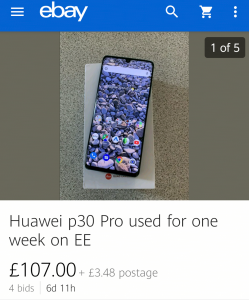 A full-scale geopolitical trade war develops between the US and China. US tech companies—who, incidentally did business with Huawei worth $15 billion to the US economy in the first quarter of this year alone—are forced to bite the bullet and cut off all connection with Huawei. IT outside the US, mostly fearing repercussions from the US, follows suit. Huawei, in turn, takes a huge hit and turns instead to domestic infrastructure and consumer sales.
A full-scale geopolitical trade war develops between the US and China. US tech companies—who, incidentally did business with Huawei worth $15 billion to the US economy in the first quarter of this year alone—are forced to bite the bullet and cut off all connection with Huawei. IT outside the US, mostly fearing repercussions from the US, follows suit. Huawei, in turn, takes a huge hit and turns instead to domestic infrastructure and consumer sales.- Trump’s ban on Huawei persuades China to ease some of its more objectionable trade restrictions. In return, the Huawei ban is lifted and business eventually returns to normal.
- Grown-ups in the Trump administration manage to steady the boat (they’ve already imposed a 90-day stay of execution) and Huawei is quietly dropped from the Entities List. A noiser version of this is that Huawei wins its court case claiming Trump’s ban is an illegal use of his “National Emergency” powers* and, following appeals, the ban is finally removed by the Supreme Court.
He was able to do this without the support of Congress on the basis that it was a “National Emergency”.
It’s tempting to see this as a ratcheting up of Trump’s almost personal trade war against the country that for many years has been manufacturing his line of Trump-branded neckties.
However, it’s important to understand that he had full bilateral congressional support for this and that the escalation putting Huawei on the Entities List that same day was the action of the US Department of Commerce.
But if this really is a “National Emergency” (and no evidence has been offered), it’s hard to see how it can be used as a bargaining chip in his trade war with China—which is what he appears to be doing.
It’s my prediction that a fire sale on the P30 Pro this year will have a very large number of takers. Why?
The device remains a first-class piece of hardware, running the latest version of Android, that will at the very least remain updated until Android 10 arrives. True, P30 Pro users thereafter will be out on a limb (according to this scenario). But a possibly fascinating adventure lies ahead for them. Huawei has said it will develop its own operating system, perhaps still based on Android (the Android Open Source Project, or AOSP, which any manufacturer can tap into without formality).
A parallel that comes to mind is the Wileyfox fiasco. The company’s chosen operating system, called Cyanogen, was based on AOSP and for a short while proved to be commercially viable. When Cyanogen collapsed in 2016 (probably due to inadequate staffing and internal squabbling) it took Wileyfox with it. But Wileyfox managed to re-emerge under new administration, adopting an evolved version of Cyanogen, called LineageOS.
LineageOS thrives today, running on phones from nearly two dozen manufacturers, Huawei among them. If Huawei, with its vast resources, proves unable to offer a better operating system than LineageOS (which I think is unlikely, good though LineageOS is), you may want to fall back on installing LineageOS, or some other Android variant, on your P30 Pro.
There’s a catch. Recently, Huawei has chosen to lock the bootloader facilities on its phones, which prevents users from installing any other operating system. It may be that Huawei is trying to avoid having to service under warranty phones that users have bricked by messing about with them.
Officially, it’s possible to obtain an unlock code direct from Huawei, in which case the company registers your phone as out-of-warranty. Unofficial lock codes are also available on the market at a price. Either way, you’ll need an unlock code before you can install any other operating system on a P30 Pro. More details here.
The Bottom Line
At the time of writing, with the P30 Pro still retailing at £900 for the 128GB version, buying new doesn’t seem to me worth the punt, much as I love the work Huawei has put into this phone.
If you can pick it up on eBay for close to half that price, go for it.
By the time new and pre-loved prices really start tumbling, of course, phones of equivalent talent from other manufacturers will be appearing. But it’s my bet that whatever happens politically, this P30 Pro will still be holding its own technically against all-comers for at least the next 18 months.
Chris Bidmead
Huawei P30 Pro
| Specifications | |
|---|---|
| Size | 8.4 x 73.4 x 158 mm |
| Weight | 192 grams |
| Waterproof | IP68 (30 minutes in a depth of 1.5m) |
| Available Colours | Aurora, Breathing Crystal |
| Display Type | OLED (multitouch capacitive) |
| Screen Aspect Ratio | 19.5:9 |
| Screen Resolution | 1080 x 2340 pixels |
| Pixel Density | 398 ppi |
| Screen To Body Ratio | 88.41% (dewdrop notch) |
| Screen Size | 6.47 inches (16.43 cm) |
| Chipset | HiSilicon Kirin 980 (64bit 8-core) |
| Graphics | Mali-G76 MP10 |
| Ram/Storage | 8GB/256GB |
| Quick Charging | 70 % in 30 minutes |
| Wireless Charging | Yes |
| Capacity | 4200 mAh (approx) |
| Wifi | Wi-Fi 802.11, a/ac/b/g/n/n 5GHz |
| Mobile Hotspot | Yes |
| Bluetooth | v5.0 |
| USB | Type C, Mass Storage, Charging, Audio, OTG |
| NFC | Yes |
| Network Support | 4G, 3G, 2G |
| Fingerprint Sensor | On-screen |
| Face Recognition | via Selfie Camera (no depth sensing) |
| Operating System | Android 9.0 (Pie) |
| Sim Slots | Dual SIM, GSM+GSM, Dual VoLTE |
| Sim Size | SIM1: Nano SIM2: Nano (also takes NanoSD) |
| Custom UI | EMUI 9.1.0 |
| General Camera Features | Ultra Macro, 50x Digital Zoom, 10x Hybrid Zoom, Depth Sensing |
| UltraWide | 20 MP, f/2.2, 16mm , 1/2.7", PDAF |
| Main | 40 MP, f/1.6, 27mm (wide), 1/1.7", PDAF, OIS |
| Telephoto | 8 MP, f/3.4, 125mm, 1/4", PDAF, OIS, 5x optical zoom |
| ToF | probably IR (see text) |
| Selfie | 32MP f2.0 fixed focus |
| Max Image Resolution | 7360 x 4912 Pixels |
| Flash | Dual-color LED |
| Video Recording | 1920x1080 @ 30 fps |
| Audio Features | Dolby Atmos (headphones only) |
| Phone ear speaker | Screen embedded |
| Loudspeaker | Mono, below screen |
| Audio Jack | USB Type-C |
